Stadio Delle Alpi

Click on the pictures to see them in full size.
The Delle Alpi stadium in Turin has often been called the stadium without a soul. The stadium has never been loved by the fans, and many have missed the old Stadio Comunale in the center of Turin. The stadium was built to host the World Cup in 1990. The city had problems finding a name for it and horrible names like Meeting and Agora were thrown away. Finally they called it Delle Alpi, since Turin is placed right under the Italian Alps. The costs of the stadium were trippled during the building. The official opening of the stadium occured the 31 of May in 1990. A mixed Juventus-Torino side defeated Porto 4-3 in a friendly match.

The Torino fans called their stand "Curva" Maratona", the same name as they had used in the retired Stadio Comunale. The Juventus fans had a hero to remember. Gaetano Scirea had died and they therefore changed the name of their stand from Filadelfia to Scirea. The Stadio Delle Alpi hosted the World Cup semifinal between Germany and England. The game had an attendance of 62 628 spectators. Here the first problem got obvious. The stadium had an official capacity of 70 040 spectators, but it became clear that it was impossible to have so many spectators due to variuos reasons.

FIFA and UEFA always demand that the clubs sell a lower number of tickets to better divide the home and away fans from each other. It was also discovered that around the entire stadium it was impossible to see the whole pitch from the lower seats. From there you could only see the promotion boards. So there has never been more than 65 000 spectators present at the Delle Alpi stadium. This record was set in the UEFA Cup final between Torino and Ajax in 1992. During the years the official capacity has been lowered even more. When Juventus and Manchester United met in the 2002-2003 season in the Champions League the stadium was sold out, but there were "only" 59 111 spectators. So the official capacity is now just below 60 000.

The legendary Juventus president Giovanni Agnelli didn't use much time to tell the press that he didn't like the new Stadio Delle Alpi. He thought the stands were too far from the pitch and that the visibility was poor. In the beginning everybody at least thought that Turin could host big Athletics Grand Prix on their brand new athletic pitch, instead it was soon discovered that this was impossible. The Delle Alpi stadium didn't have a warm up track and it was therefore impossible to arrange International Athletic Grand Prix there. One time only, in 1993, has there been an athletic competion at the Stadio Delle Alpi. So the stadium has a huge athletic pitch which not only reduces the visibility of the spectators, but it is also impossible to use for athletics! Spectators with bad seats can in some cases find themselves 162 metres from the ball during the game.

Another case soon caused new problems. Publi-Gest, the agency that had the responsibilty of maintainance of the stadium soon started fighting with the two Turin clubs over the rent of the stadium. Juventus and Torino had to pay more than the other Serie A clubs for the rent of the stadium. When Juventus got a new management in 1994(Umberto Agnelli, Giraudo, Moggi and Bettega), they immediately started talking about building a new stadium. They said that the costs of the Delle Alpi were too high and that they wanted a new deal. The city of Turin tried to help the parts reach an agreement, but without any luck. When the situation deteriorated Juventus decided to move their 1994-1995 Uefa Cup semifinal and final from Turin to Milan. This was a warning both to the city of Turin and to the unpassionate fans in Turin. The two games which were played at the San Siro stadium both had a 85 000 crowd. Only a few times during the 13 years of life has the stadium been sold out. Only in the really great and important matches have Juventus been able to sell all their tickets.

The Stadio delle Alpi is the most maligned ground in Italy. Built at huge expenses for the 1990 World Cup, its location on the outskirts of town, its soulless atmosphere, and even exposure to the Alpine winds whistling in from the north, have had both occupants Juventus and Torino, yearning to build new stadiums. On days of poor crowds the Delle Alpi stadium can be a gloomy, silent experience. Under an impressive roof supported by tension cables, surrounded by car parking and wide approach roads, and with a huge gap between spectators and the pitch thanks to a a running track.

In theory the venue seemed the perfect arena for families to drive to, park the car, enjoy a spectacle and drive home again. In practice, for football fans it was far from ideal. It was not long before fans, players, pressmen and officials were complaining about the stadium's inconvenience, lack of atmosphere and poor view. The Stadio Delle Alpi will not be remembered for it's atmosphere, but for the trophies conquered there, great games and the great players who played there (Baggio,Del Piero, Zidane). Few people will miss the stadium when the new one is ready.

Juventus will play at the Stadio Olimpico until 2008

In await of their new stadium, Juventus will play the next two seasons at the new Stadio Olimpico in Turin. The stadium was opened for the Winter Olympics in Turin in February 2006. The new stadium, who will be the new permanent home of Torino F.C and the temporariy home of Juventus F.C, already has many critics. At the beginning of the project the constructors talked about a 31 000 capacity, then at the presentation of the project in september 2003 the capacity was set to 28 000. Now three years later the official capacity has been reduced to 25 400.

This is a capacity that Torino F.C find far too low for their demand. Torino F.C almost had 25 000 in average attendance in Serie B last season. This made the Torino President contact Juventus in the summer of 2006 to ask if they could play the big matches in the Serie A at the Delle Alpi Stadium. Juventus are the owners of the Delle Alpi, but responded no because the costs of maintanence of the stadium are huge. Juventus therefore intend to do nothing about the Delle Alpi until they are ready to build their new stadium inside it.

Many Torino and Juventus supporters will be very happy to return to the Stadio Olimpico, formerly the Stadio Comunale. Both clubs have spent most of their history in that stadium. Although the Stadio Comunale had a 70 000 capacity, few seats and a short roof, the new Stadio Olimpico still looks a lot like it. Only with a third of the capacity, all seats and all covered.

The new Stadio Olimpico has also been criticised because the constructors has put too much space between the seats, and because the seats in the Curvas are too big. This makes standing up during the games more difficult. The new Stadio Olimpico can also cause serious economic damage to Torino F.C in the future. Not only because they can sell fewer tickets, but specially because in the immediate future 25% of the TV-rights money will go to the clubs with the highest average attendances.

A picture of the old Stadio Comunale.
The new Juventus stadium
The building of the new Juventus stadium was supposed to finally start in June 2006, but as a result of the Calciopoli scandal that relegated Juventus to the Serie B, the entire Juventus Board resigned. This naturally caused a new delay of the new stadium. Then a month later the new Juventus board announced that they didn't like the new Stadium that Giraudo and the old board had planned, and that they needed some more time to create new and satisfying plans. This means that nobody knows when the plans will be ready, when they can start building or when the new Juventus stadium will be ready. The only thing that is certain is that Juventus will play at the Stadio Olimpico in the next two seasons.



The latest and final stadium project.
The new stadium that Giraudo wanted to build
In 2002-2003 changes in politics and in the city council allowed a satisfying solution for Juventus and Torino. In the summer of 2003 Juventus finalized the deal with the city council of Turin and bought the Delle Alpi stadium. Juventus paid the city council 25 million Euros for the stadium that was built in 1990. The Juventus directors were deligthed with the deal. Giraudo and the board wanted to build a new stadium inside the current Delle Alpi stadium. The running pictch would be removed and the spectators would sit only few meters from the pitch like in English stadiums. The capacity would be reduced to 35 000 seats.

In Oktober 2004 the directors announced that the new Juventus stadium would have a sponsor name. Juventus announced that they had made an agreement with the Los Angeles firm Wasserman Media group Envision to find a sponsor for the new Juventus stadium. The new stadium would not be named after the Agnelli family as the fans hoped for, but after a sponsor. Juventus wanted to follow the example of Arsenal who named their new stadium for Emirate stadium. The new stadium planned by Giraudo was supposed to be ready in 2008.

Juventus also planned to build outside the stadium. Juventus planned to build a hotel, a shopping centre, a Juve store, a Juventus museum, a cinema, a bowling hall, restaurants and new offices for the club. The work was supposed to start in June 2006 and end in August 2008. The construction work was originally supposed to begin in May 2004, but various delays made the Juventus directors postpone it a year. Then they were supposed to start building in the summer of 2005, but the construction works were once again postponed until next summer. In oktober 2005 Giraudo confirmed that the building of the new Juventus stadium would start in May 2006. The new Juventus stadium was estimated to cost approximately 150 Million Euros.

The negotiations of the purchase of the Delle Alpi lasted six years. Bad weather and poor pitch conditions is not unusual in Turin. Therefore Juventus also considered to build a glass roof over the new Delle Alpi stadium. Juventus wanted to bring the seats within 10 to 15 metres from the field. Currently the closest a spectator can get is 23-40 metres. The other seating area would become conference rooms for use during the week for conventions or work related gatherings.

Juventus hoped to rise their profit from the stadium, which currently is far below the clubs from Milan and Rome. Juventus currently profit between 10 Million and 15 Million Euro from the stadium. The new stadium would have a square design, and not a oval design like the current Delle Alpi stadium. The solution of reducing the capacity to only 35 000 created many protests among the Juventus fans. The club also hoped that the shops and entertainment features that would be built around the stadium would bring the fans to spend more time in the stadium area.
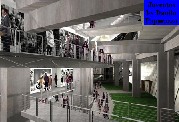
Alternative stadium projects


This was the first idea of how the new Juventus stadium would look like.


This was the second idea of how the new Juventus stadium would look like.
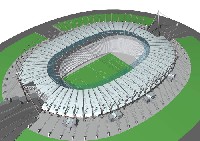


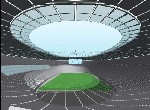
This was the third idea of how the new Juventus stadium would look like.
Practical information about the Delle Alpi
Getting to the stadium:
From Turin's Caselle Airport either take a taxi directly to the stadium or a bus to the city centre. Porta Nuova station has connections with all major Italian cities.
Tram 9 runs from the Porta Nuova station to the Stadio delle Alpi on the northern outskirts of the city by the main ring road. The journey can take up to 30 minutes. The tram stops at Piazza Stampalia, a short walk from the stadium
Bus nr 72 starts at the corner between Via XX Settembre and Via Bertola in the city centre. This journey can take up to 40 minutes. The bus stops right outside the Stadio Delle Alpi. After the games this bus is extremely crowded and full of foreign pickpockets. So my suggestion is to take the Tram instead of the bus.
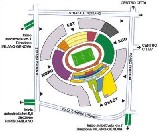
Tickets:
The Stadio delle Alpi is divided into three tiers, or anelli. The highest, 3 anello, offers only a bird’s eye view. The lowest, 1 anello, is sunk very deeply. The best seats are the distinti centrale in the 2 anello, over the halfway line although these are the most expensive. Juventus fans gather behind the south goal, in la Curva Scirea. The Stadio Service behind the south goal at via Sansovino 229, sells advance tickets in the run-up to match day, as do the various ticket shops around Turin. A handful of ticket booths are dotted around the ground on match days. Only a few games each season are sold out, so there is normally no problems finding tickets.
You can book tickets online from: http://www.listicket.it/juventus_fc or get them in Turin from any of a number of Lottomatica lottery pay points. Some of the most convenient in the centre are at Piazza Emanele Filiberto 7, Piazza Palazzo Di Città 6f, Via Arsenale 1 and Via Cernaia 16c. Tickets booked online can be picked up at the stadium, at desk No 1 outside your section, from a couple of hours before kick off. You'll need ID and your booking reference. Ticket prices vary according to the match, but for a Serie A game they start at 20 Euros for a seat in the Curva Nord or Curva Sud.

Where to sit:
La Curva Scirea is the place to be if you want to stand, sing and cheer for 90 minutes while watching Juventus. The 2 anello is the most attractive and is completely sold out with season tickets. It is very difficult to get tickets to the 3 anello, while it's almost always possible to get tickets to the 1 anello. If you go to la Curva Scirea don't complaine if the fans have a big flag in front of your eye view, the most important thing here is to sing for Juventus and make Tifo, not to watch the game. La Curva Scirea has a capacity of 15 260 spectators.

La Curva Nord behind the north goal hosts Centro Juventus Club, but it has lost its appeal after the Juventus directors decided to remove the Ultras groups from this stand. It is easy to get tickets to the 1 and 3 anello, while more difficult to get tickets to the 2 anello which is the best.

La Tribuna Est is were "regular" fans go. The 2 anello is the best, but also the most expensive. The 1 anello is very low, while the 3 anello is very high. If there's not a big game on the programme, you will find tickets to all three annellis. La tribuna Est is the place to sit if you are more concerned about watching the game than singing. And it's far cheaper than la Tribuna Ovest. At both ends of la Tribuna Est you find two more sections. The section near to la Curva Nord is reserved to the away supporters. The section near to la Curva Scirea, EST 4, is reserved to the Juventus fans, and is a little bit cheaper than the more sentral seats in this stand.
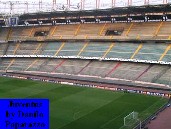
La Tribuna Ovest is the most expensive stand at the Delle Alpi stadium. The 2 anello is reserved to the press, commentators and very important persons. The view from the 1 and 3 anello is exactly the same as from la Tribuna Est, but the tickets here cost much more and are always the last to be sold. It has to be a extremely important game if you don't manage to get tickets for la Tribuna Ovest.
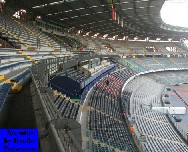
Recomended things to see in Turin:
La Mole Antonelliana: For a bird's eye view of Turin, the surrounding hills and the Alps beyond, take the glass lift up to the viewing terrace of La Mole. Originally planned to be a synagogue, this is actually Italy's highest building and the views from the top are spectacular.
National Cinema Museum: The Cinema Museum is in the same building as La Mole Antonelliana. Sections on the history of the cinema are interspersed with famous film sets that you can actually walk through, spiralling up the inside of the dome. Films are shown on both large and small screens throughout.
Piazza Castello: This is the city's main square. Palazzo Madama in the centre is a curious building with three different styles built into each other. To one side of the square is Palazzo Reale, a huge palace. You can visit the plush stately rooms, but guided tours are compulsory.
Turin's Hole Shroud: This is one of the city's biggest boasts. It is stowed horizontally in a casket in the cathedral, San Giovanni, but a full size copy is on show. A separate museum tells the recent history of the shroud, but gives no certainities as to whether or not it really is the sheet Jesus was wrapped in after his crucifixion.
Superga: Take the funicular up to the Superga hill and basilica. It was here that the entire Torino football team, Italian champions at the time, lost their lives in an air crash in 1949 on their way back from a match in Lisbon.
Parco del Valentino: This park on the banks of the River Po contains a couple of castles, one real, built in the 17th century, and a fake, medieval one built for Italy's General Exposition in 1884. This is surrounded by an equally fake, but appealing medieval village.
Juventus Stores: The impressive Juventus Store is in the city's main pedestrianised shopping street, Via Garibaldi, at number 4/e. There's also a branch at the stadium and another one at Turin's Caselle airport.
Back to main page

Copyright: Danilo Paparazzo




































